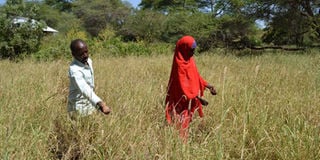Pastoralists find formula to defeat dry spell

Two of Malki Bisan Adi Cultural Village, members in one of their grass farms in Isiolo. At the cultural village, herders grow Boma Rhodes grass on a huge piece of land for fattening their weak animals. PHOTO | ISAIAH ESIPISU | NATION MEDIA GROUP
What you need to know:
- Arid and semi-arid areas host about 70 per cent of the national livestock herd.
- With technical support from Pastoralism Research for the Future Agricultures Consortium, representatives from local communities mapped their rangelands.
- The conflicts were rampant during drought since the rangelands were never managed, and by the time the rainfall subsided, the animals had nowhere to graze.
- The arid and semi-arid areas host about 70 per cent of the national livestock herd with an estimated value of about Sh70 billion.
Livestock is the main source of livelihood in many arid and semi-arid regions, and also one of the main sources of conflict among pastoralists.
The conflicts escalate especially during the times of drought when there is scarcity of pasture.
In northern Kenya, however, communities are coming up with solutions to address shortage of pasture and thus conflicts.
The Borana are doing it by dividing their rangelands into three sections. That is, one for grazing during the rainy season, the other when it is moderately dry, and the last when it is extremely dry.
Since 2013 when they started the practice after getting lessons from a community organisation, the Borana community members in Garbatulla and Merti regions in Isiolo County are now living in peace, feeling very little impact of the drought, and losing the least of livestock compared to other pastoralist communities.
“This did not just happen,” Salad Boru, the assistant chief in Gubadida told Seeds of Gold. “It called for formal and informal research, negotiation with representatives from the entire community, involvement of the local administration and humanitarian organisations,” he said.
With technical support from Pastoralism Research for the Future Agricultures Consortium, representatives from local communities mapped their rangelands.
The main objective of the exercise was to identify major livestock migratory corridors and map out dry and wet season grazing areas within the areas.
Wet grazing areas in Merti were identified as Tiyole, Mado, Roble, Komor Bula, Moliti, Biliqi, Dakara, Hawaye, Kubi and Kuri.
During the dry seasons, the main focal areas in Merti were identified as Marado, Kubi Dimtu, Mogore and Diuo Wara.
In Garbatulla, 16 areas were identified as grazing zones during wet seasons and eight areas including Kubi Roba, Kubi Haqe, Kuku and Baqasa as grazing zones during dry seasons.
RAMPANT CONFLICTS
Based on the results, said Boru, community elders and officers from the local administration were invited to a special forum, where basic rules were drafted to help in governing the grazing patterns.
At the forum, stewards were identified to help in management of the grazing zones, and ensure that herders do not take their livestock to particular zones before they are permitted by the committee of elders.
“This has helped in regeneration of our rangelands in secured zones because once animals are restricted from entering particular areas, then pasture grows,” said Makai Intalo, the chairlady of Malki Bisan Adi Cultural Village, which consists of groups of herders.
“This is like managing what you can eat today while saving some for tomorrow,” she added.
At the cultural village, herders grow Boma Rhodes grass on a huge piece of land for fattening weak animals.
“Because of the rangeland management plan, our animals rarely get weak, and that’s why we are planning to sell the grass to other pastoralist communities,” said Intalo, noting the plan has helped reduce conflicts with neighbouring communities.
The conflicts were rampant during drought since the rangelands were never managed, and by the time the rainfall subsided, the animals had nowhere to graze.
“This forced herders to move to neighbouring communities, which would always resist leading to conflict,” said Nura Kampure from Kinna in Isiolo.
The herders said the community has lost very few animals due to tough climatic conditions, including in the recent drought, since the plan was started.
Ministry of Agriculture records indicate that livestock contributes 10 per cent of the country’s gross domestic product and 50 per cent of the agriculture output.
The arid and semi-arid areas host about 70 per cent of the national livestock herd with an estimated value of about Sh70 billion.





